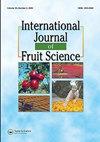遮荫减少草莓营养生长期间的水分亏缺
IF 2.4
3区 农林科学
Q2 HORTICULTURE
引用次数: 3
摘要
草莓(Fragaria × ananassa Duch.)是一种高需水量的重要商业作物,因此制定缓解水分亏缺对植物生长影响的策略是必要的。本研究旨在评价遮荫对草莓幼苗营养生长的影响。甜安缺水。处理包括两个层次的遮荫(光照强度比无遮荫植物降低47%)和两个层次的水分利用(水分亏缺比水分充足的植物)。水分亏缺使叶片水势从−1.52降至−2.21 MPa,气孔导度、净光合速率(从9.13降至2.5µmol m−2 s−1)、PSII光化学最大量子效率(从0.79降至0.67)和生物量积累降低,但电解质泄漏增加。与没有水分限制的遮荫植物相比,遮荫使缺水植物保持了水势(- 1.58 MPa)和光系统II效率(0.79),提高了水分利用效率(从14.80增加到86.90µmol CO2/mmol H2O),净光合速率(从2.40增加到9.40µmol m−2 s−1)和叶、冠和根的生物量。这些结果首次在草莓中表明,入射光强的降低减弱了草莓营养生长过程中水分亏缺引起的气孔和非气孔限制的影响。本文章由计算机程序翻译,如有差异,请以英文原文为准。
Shading Reduces Water Deficits in Strawberry (Fragaria X Ananassa) Plants during Vegetative Growth
ABSTRACT The strawberry (Fragaria × ananassa Duch.) is a commercially important crop with high water requirements, making strategies that mitigate the influence of water deficits on plant growth necessary. This study aimed to evaluate the effects of shading on the vegetative growth of strawberry cv. Sweet Ann under a water deficit. The treatments consisted of the combination of two levels of shading (light intensity reduced by 47% vs. non-shaded plants) and two levels of water availability (water deficit vs. well-watered plants). The water deficit reduced the leaf water potential from −1.52 to −2.21 MPa, and diminished stomatal conductance, net photosynthetic rate (from 9.13 to 2.5 µmol m−2 s−1), maximum quantum efficiency of PSII photochemistry (from 0.79 to 0.67), and biomass accumulation, but increased the electrolyte leakage. The shading allowed the water-deficient plants to maintain water potential (−1.58 MPa) and photosystem II efficiency (0.79) and to increase water use efficiency (from 14.80 to 86.90 µmol CO2/mmol H2O), net photosynthetic rate (from 2.40 to 9.40 µmol m−2 s−1) and biomass of leaves, crowns, and roots, as compared to the non-shaded plants without a water limitation. These results suggest, for the first time in strawberry, that a reduction in incident light intensity attenuates the effects of stomatic and non-stomatic limitations caused by a water deficit during vegetative growth in strawberry.
求助全文
通过发布文献求助,成功后即可免费获取论文全文。
去求助
来源期刊

International Journal of Fruit Science
Agricultural and Biological Sciences-Agronomy and Crop Science
CiteScore
6.40
自引率
0.00%
发文量
64
审稿时长
10 weeks
期刊介绍:
The International Journal of Fruit Science disseminates results of current research that are immediately applicable to the grower, extension agent, and educator in a useful, legitimate, and scientific format. The focus of the journal is on new technologies and innovative approaches to the management and marketing of all types of fruits. It provides practical and fundamental information necessary for the superior growth and quality of fruit crops.
This journal examines fruit growing from a wide range of aspects, including:
-genetics and breeding
-pruning and training
-entomology, plant pathology, and weed science
-physiology and cultural practices
-marketing and economics
-fruit production, harvesting, and postharvest
 求助内容:
求助内容: 应助结果提醒方式:
应助结果提醒方式:


